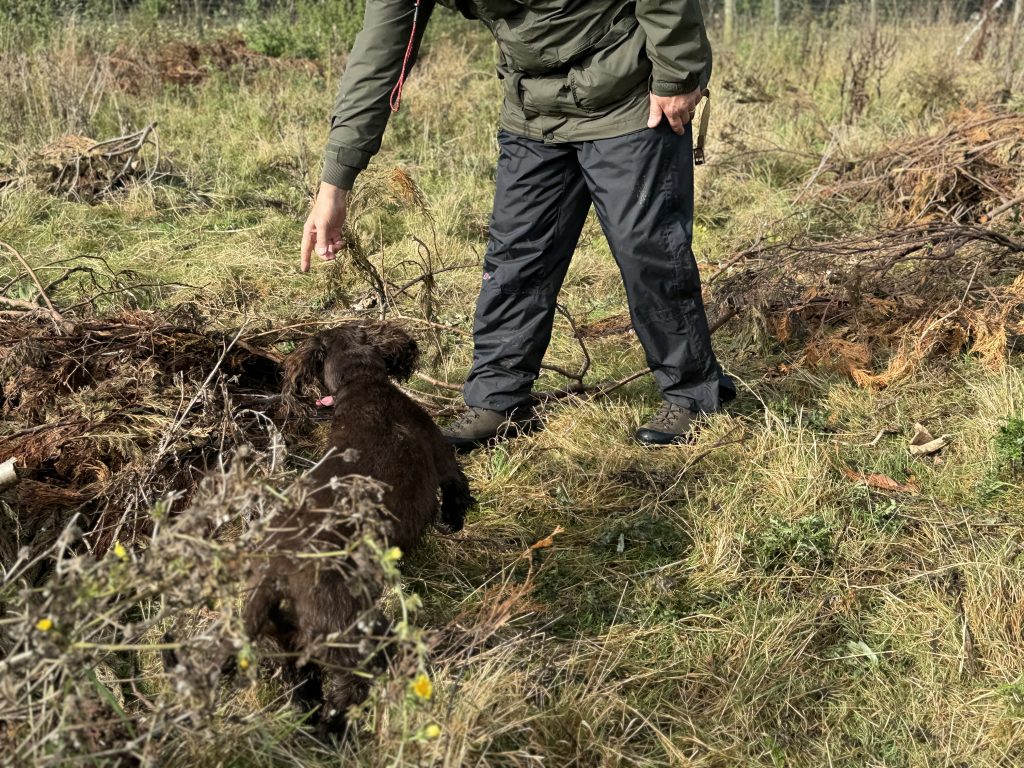
Driven game shooting is a time-Honoured tradition in the UK, with pheasant, partridge, and other game birds being flushed towards positioned Guns. Among the critical elements that make these shoots successful is the role of beating dogs. These specially trained dogs assist the beating team by flushing gamebirds from thick cover, ensuring the smooth operation of the shoot. In this blog, we’ll explore the indispensable role of beating dogs in UK shooting and why their skills are so vital.
What is Beating?
Before delving into the dog’s role, it’s important to understand the concept of “beating.” In driven shooting, beaters are responsible for encouraging birds to fly out of dense undergrowth and woodland, driving them towards the waiting Guns. Beaters move through wooded areas, cover crops, and hedgerows, using flags and sticks to create noise and movement. While the human beaters play a key part in the drive, dogs are essential to reach the places humans can’t, particularly thick cover and difficult terrain.
What Does a Beating Dog Do?
A beating dog is a highly trained working dog, used to locate and flush gamebirds from dense cover such as brambles, tall grass, or woodland. Their role is to assist the beaters by searching out birds and ensuring they fly in the direction of the Guns. The dog’s combination of agility, intelligence, and strong instincts makes them the perfect partners for beating teams. Here are some of the key tasks they perform:
1. Flushing Game
The primary job of a beating dog is to flush birds out of hiding. With their keen sense of smell and instinct for locating birds, beating dogs work methodically through dense areas to find game that might otherwise remain undisturbed. Once located, the dog will push the bird into the air, encouraging it to fly towards the Guns.
2. Navigating Dense Cover
Beating dogs are invaluable when it comes to accessing thick cover. Birds tend to hide in dense undergrowth or bracken, making it difficult for human beaters to get close. However, dogs, with their size and agility, can easily push through these tough areas. Their ability to move swiftly through dense terrain allows them to locate and flush birds that might otherwise be missed.
3. Control and Precision
A well-trained beating dog is under complete control at all times. Their job is not to chase or retrieve but to work alongside the beaters, flushing birds in a calm, controlled manner. The dogs must remain steady and focused, never breaking or flushing birds prematurely. They are taught to work in a disciplined manner, keeping pace with the beaters and reacting to commands.
4. Working as Part of a Team
The beating line, which often consists of both human and canine members, works together to push gamebirds towards the Guns. Beating dogs are trained to understand this team dynamic, working in harmony with other dogs and the beaters. They need to maintain a balance between independence—using their initiative to find birds—and obedience to their handler’s commands.
Types of Beating Dogs
Several breeds are commonly used as beating dogs in the UK, each bringing unique skills to the role. Some of the most popular breeds include:
• Spaniels: Cocker Spaniels and Springer Spaniels are the most widely used beating dogs. Their small size, energy, and exceptional nose make them ideal for working through dense cover. Spaniels are particularly good at quartering, where they work back and forth across the ground in front of the handler to ensure no area is left unchecked.
• Labradors: Though more commonly associated with retrieving, Labradors can also make excellent beating dogs. Their strong work ethic, intelligence, and steady nature make them a reliable choice for flushing game in more open terrain or lighter cover.
• Terriers: Some shoots use terriers as beating dogs, particularly when working in very dense undergrowth where larger dogs may struggle. Their tenacity and fearlessness in tough environments make them well-suited to flushing game from tricky areas.
Training a Beating Dog
Training a beating dog requires patience, consistency, and a deep understanding of both the dog’s natural instincts and the demands of driven shoots. The goal is to develop a dog that can work independently but remain under control at all times. Key elements of beating dog training include:
• Steadiness: A beating dog must be calm and controlled, not breaking from the line or chasing after game once flushed. They need to stay focused and work at the pace of the beaters.
• Quartering: Dogs are taught to work in a zigzag pattern in front of the handler, ensuring they cover the ground evenly and thoroughly.
• Flushing: Dogs are trained to gently push birds out of cover, encouraging them to fly towards the Guns. They must learn not to scare or force the birds prematurely but flush them at the right time.
Why Beating Dogs are Vital
Beating dogs are an indispensable part of any driven shoot in the UK. Their ability to navigate dense cover, flush out hidden birds, and work in harmony with the beating team makes them a crucial asset. Without these hardworking and skilled dogs, many birds would remain hidden, and the effectiveness of the shoot would be significantly diminished.
Additionally, the presence of beating dogs adds to the enjoyment of the day for many participants. Watching a well-trained dog at work, whether it’s a spaniel darting through the undergrowth or a Labrador flushing game from the field, is one of the most rewarding aspects of the shoot.
Conclusion
In the world of driven shooting, the beating dog is a hero behind the scenes. Their skill, intelligence, and energy make them essential to the success of a shoot, ensuring that gamebirds are flushed from even the densest cover and driven towards the Guns. As integral members of the beating team, these dogs demonstrate the power of partnership between humans and canines in a traditional countryside pursuit that continues to thrive in the UK.
